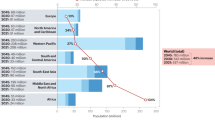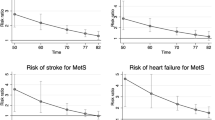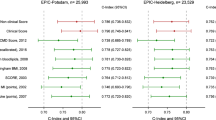Abstract
Much controversy has surrounded both the pathological basis and the clinical utility of the metabolic syndrome. Key questions still revolve around the definition of this syndrome, its utility as a predictor of cardiovascular risk, and the treatment implications of diagnosis. The metabolic syndrome is associated with increased cardiovascular risk. However, the metabolic syndrome clearly underperforms compared with other, established prediction equations, such as the Framingham Risk Score and SCORE (Systemic COronary Risk Evaluation). Differences arise because the components are highly correlated (whereas other tools specifically include independent predictors) and because diagnosis is based on dichotomized variables. These facts, together with uncertain pathophysiology, mean that the metabolic syndrome in its current manifestation has limited utility for the diagnosis and treatment of cardiovascular disease. The syndrome has, however, served and continues to serve a useful purpose in raising awareness of the metabolic consequences of obesity, and as a spur for research into metabolic risk factor interactions.
Key Points
-
Metabolic syndrome is associated with increased cardiovascular risk
-
The total risk associated with metabolic syndrome might be greater than that of its component parts, although the evidence for this is not clear
-
Metabolic syndrome performs poorly compared with tools designed specifically to identify individuals at increased cardiovascular risk
-
There is no single mechanism that underlies the pathophysiology of the metabolic syndrome, and pharmacological treatment should, therefore, be restricted to treating individual risk factors according to established guidelines
This is a preview of subscription content, access via your institution
Access options
Subscribe to this journal
Receive 12 print issues and online access
$209.00 per year
only $17.42 per issue
Buy this article
- Purchase on Springer Link
- Instant access to full article PDF
Prices may be subject to local taxes which are calculated during checkout


Similar content being viewed by others
References
Reaven GM (1988) Banting lecture 1988. Role of insulin resistance in human disease. Diabetes 37: 1595–1607
Expert Panel on Detection, Evaluation, and Treatment of High Blood Cholesterol in Adults (2001) Executive Summary of the Third Report of The National Cholesterol Education Program (NCEP) Expert Panel on Detection, Evaluation, and Treatment of High Blood Cholesterol in Adults (Adult Treatment Panel III). JAMA 285: 2486–2497
Alberti KG and Zimmet PZ (1998) Definition, diagnosis and classification of diabetes mellitus and its complications. Part 1: diagnosis and classification of diabetes mellitus provisional report of a WHO consultation. Diabet Med 15: 539–553
Alberti KG et al. (2005) The metabolic syndromea new worldwide definition. Lancet 366: 1059–1062
Kahn R et al. (2005) The metabolic syndrome: time for a critical appraisal: joint statement from the American Diabetes Association and the European Association for the Study of Diabetes. Diabetes Care 28: 2289–2304
Grundy SM (2005) Point: the metabolic syndrome still lives. Clin Chem 51: 1352–1354
Gotto AM Jr et al. (2006) The metabolic syndrome: a call to action. Coron Artery Dis 17: 77–80
Ruderman NB et al. (1981) The “metabolically-obese,” normal-weight individual. Am J Clin Nutr 34: 1617–1621
Gami AS et al. (2007) Metabolic syndrome and risk of incident cardiovascular events and death: a systematic review and meta-analysis of longitudinal studies. J Am Coll Cardiol 49: 403–414
Lorenzo C et al. (2007) The National Cholesterol Education Program–Adult Treatment Panel III, International Diabetes Federation, and World Health Organization definitions of the metabolic syndrome as predictors of incident cardiovascular disease and diabetes. Diabetes Care 30: 8–13
Ridker PM et al. (2002) Comparison of C-reactive protein and low-density lipoprotein cholesterol levels in the prediction of first cardiovascular events. N Engl J Med 347: 1557–1565
Ridker PM et al. (2003) C-reactive protein, the metabolic syndrome, and risk of incident cardiovascular events: an 8-year follow-up of 14 719 initially healthy American women. Circulation 107: 391–397
Asselbergs FW et al. (2004) Framingham score and microalbuminuria: combined future targets for primary prevention? Kidney Int Suppl 92: S111–S114
Lagakos SW (1988) Effects of mismodelling and mismeasuring explanatory variables on tests of their association with a response variable. Stat Med 7: 257–274
Royston P et al. (2006) Dichotomizing continuous predictors in multiple regression: a bad idea. Stat Med 25: 127–141
Anderson KM et al. (1991) Cardiovascular disease risk profiles. Am Heart J 121: 293–298
Conroy RM et al. (2003) Estimation of ten-year risk of fatal cardiovascular disease in Europe: the SCORE project. Eur Heart J 24: 987–1003
Pinto-Sietsma SJ et al. (2000) Urinary albumin excretion is associated with renal functional abnormalities in a nondiabetic population. J Am Soc Nephrol 11: 1882–1888
Bakker SJL et al. (2007) Metabolic syndrome: a fata morgana? Nephrol Dial Transplant 22: 15–20
Wannamethee SG et al. (2005) Metabolic syndrome vs Framingham Risk Score for prediction of coronary heart disease, stroke, and type 2 diabetes mellitus. Arch Intern Med 165: 2644–2650
Lasko TA et al. (2005) The use of receiver operating characteristic curves in biomedical informatics. J Biomed Inform 38: 404–415
Deedwania PC and Volkova N (2005) Current Treatment Options for the Metabolic Syndrome. Curr Treat Options Cardiovasc Med 7: 61–74
Grundy SM (2006) Metabolic syndrome: connecting and reconciling cardiovascular and diabetes worlds. J Am Coll Cardiol 47: 1093–1100
Sironi L et al. (2005) Anti-inflammatory properties of drugs acting on the renin-angiotensin system. Drugs Today (Barc) 41: 609–622
National Cholesterol Education Program (NCEP) Expert Panel on Detection, Evaluation, and Treatment of High Blood Cholesterol in Adults (Adult Treatment Panel III) (2002) Third Report of the National Cholesterol Education Program (NCEP) Expert Panel on Detection, Evaluation, and Treatment of High Blood Cholesterol in Adults (Adult Treatment Panel III) final report. Circulation 106: 3143–3421
Acknowledgements
PAREXEL MMS provided writing assistance, comprising preparation of a draft from slides and audio transcript, preparation of figures and obtaining copyright permissions, proofreading, and reference checking.
Author information
Authors and Affiliations
Corresponding author
Ethics declarations
Competing interests
The authors declare no competing financial interests.
Rights and permissions
About this article
Cite this article
de Zeeuw, D., Bakker, S. Does the metabolic syndrome add to the diagnosis and treatment of cardiovascular disease?. Nat Rev Cardiol 5 (Suppl 1), S10–S14 (2008). https://doi.org/10.1038/ncpcardio1271
Received:
Accepted:
Issue Date:
DOI: https://doi.org/10.1038/ncpcardio1271



